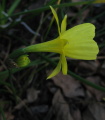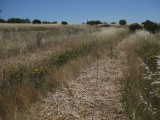The quest for fertile inter-sectional division 5’s is progressing very slowly here. The policy of putting sterile triploids onto fertile inter-sectional tetraploids is being pursued but very few seeds have been obtained. Mission Bells was very reluctant this year but it appears to have been happy to produce a seed when crossed with the fertile bulbocodium hybrid (Flash Affair x bulbocodium). There seems to be an unusual compatibility between the bulbocodiums and triandrus and unexpected fertility.
A few more triandrus triploids with some pollen fertility have been identified and two new ones attempted to set seed. And a few main division crosses were made with the view to producing good parents to cross with triandrus – nodding poise, bowl and goblet shaped cups, reflex and multi-headed. I think the growing list of division 6 tetraploids should be crossed with species triandrus.
My own pollen fertile triandrus hybrid, 04_01RM is producing hybrids with fertility.
A number of the (Mission Bells x 04/1RM) set a seed or two. Possibly 12_01RM is the best of them.
12_01RB is bulbocodium x (triandrus x 04/1RM). It seems to reliably set seed, although it is not clear that such hybrids will be useful.
The most fertile hybrid this year was 12_02MB which is the bulbocodium hybrid Gold Step x 04/01RM. It will be interesting to see whether these hybrids will lead to good fertile intersectional triandrus hybrids.
I have a feeling that in the various climates daffodils die down differently. Here they usually get baked. It is easy to see that the daffodils that flowered a couple of weeks ago have no chance of setting seed. Why the very late poet does as well as it does is a bit of a mystery. So on a completely different topic, here is a photo from yesterday.





Lawrence,
A few of us have successfully bred first generation Div 5 miniatures. However it has been a real problem to keep them from beyond the first or second flowering. I wonder if you could comment on this as it seems to me to be fine to get fertility into the division but how can we add durability to this? Is there a key? Even in the standards there are relatively few successful cultivars.
Dave
Hi Dave,
In my experience the most robust (and attractive) hybrids have some jonquil ancestry but these seem hopelessly sterile in principle and in practice. (I reported last year that I may have had a seed from a fernandesii x triandrus seedling but it is now clear I definitely did not.)
The ideal cultivars will look like triandrus but in all the various colors, both standard and miniature. I think that most standard 5’s are gross – they don’t nod or reflex enough and look like bad 7’s. I have suggested before that there are all the elements of triandrus in the narcissus/pseudonarcissus. The nodding poise, reflex, and bowl shaped cups aren’t too difficult. I think the best flowers will be tetraploid and these are being bred down in size so I would look to miniatures through them. It is obvious to me that tetraploid 6’s have a lot to offer. But 2 headed flowers are quite rare and although I always select flowers with this characteristic I have not stabilised it. I very much doubt that nevadensis or longispathus will help. I have a passably 2 headed poet from Frank’s Fancy and I would dearly like to have John Reed’s Poet Laureate. I expect both are diploid. I am now of the view that the ploidy is less of a concern than the problem that poets are not sunproof. Each year a few cyclamineus come double headed and the 06_50D seedling shown in the div. 6 update is often 2 headed. It might be interesting to put its pollen onto a triandrus-like standard.
So I think the way forward is to breed more triandrus-like standards (the normal tetraploids in division 1-3), cross these with triandrus and find plants with some fertility which are then crossed with fertile intersectional tetraploids such as Mission Bells in the hope of obtaining more such fertile hybrids. The durability problem should get sorted out in this process. Obtaining colored fertile miniatures looks more difficult, but Ian Dyson gave me Little Toot this year and it looks very promising. The flowers bred down in size from standard breeding are tetraploid in my experience and therefore perfect for the task. Larry Force mentioned Red Socks last year (http://daffnet.org/more-on-division-six-fertility/) – it looks very promising eg. Mission Bells x (Red Socks x triandrus) – but for durability a bit more distance from cyclamineus might be better.
The big question mark for me is what contribution bulbocodiums can make, because there seems to be an unusual compatibility between them and triandrus. They may be able to add great qualities but it is hard to imagine them contributing to hybrids that are very like triandrus any time soon.
Another sacrilegious thought that comes to mind is to select fertile nodding reflexed division 7’s and call them 5’s – the Limequilla type hybrids. This is not so far fetched. The injection of viridiflorus (Emerald Sea) and perhaps even cyclamineus (via fernandesii x cyclamineus) into this group could see this happening very soon. John Hunter’s Autumn Charm is not too far off. It is probably sterile but it may resemble the genetics of Gertrude Nethercote and so putting its pollen onto Quickstep (or vice versa) might give the required result.
Thanks for a thoughtful reply Lawrence